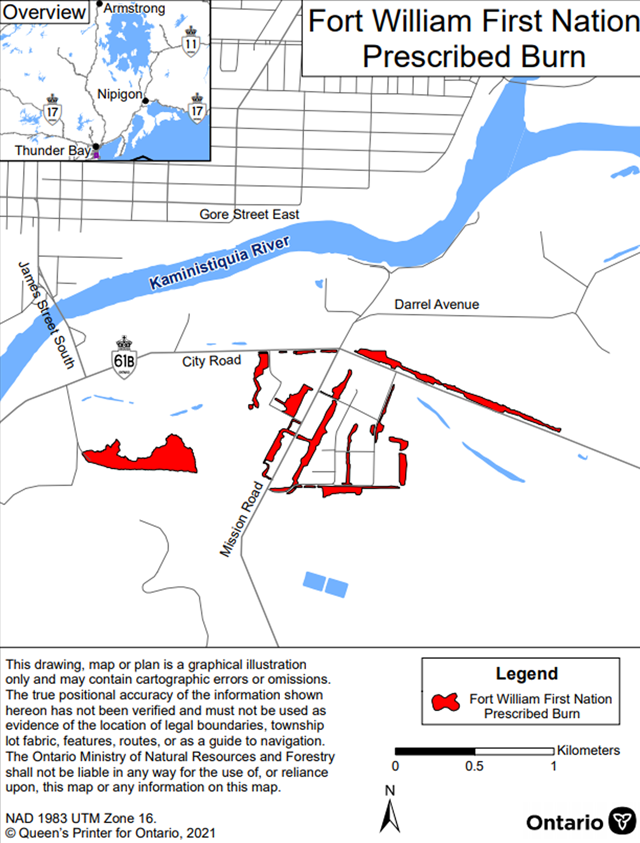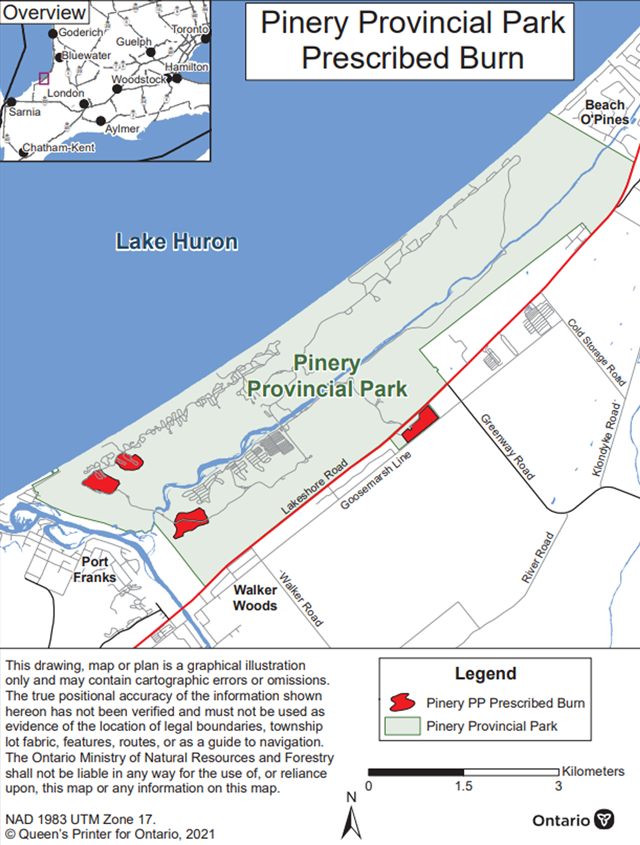Prescribed burns
The benefits of prescribed burning and how you can get approval to carry out a burn in Ontario’s forests.
Prescribed burns – 2021
Prescribed burns are carefully planned and conducted to minimize the chance of wildland fires.
We have plans for prescribed burns in the following areas:
- Fort William First Nation – Thunder Bay District
- Hogarth Plantation - Thunder Bay District
- Lofty Davies – Nipigon District
- Mishkeegogamaang Independent First Nation – Sioux Lookout District
- Nawiniinginokiima Forest - Wawa District
- Pinery Provincial Park
- Sandy Lake First Nation - Red Lake District
- Steep Rock Mine Rehabilitation Project
- Wabaseemoong Independent First Nation – Kenora District
Fort William First Nation – Thunder Bay District
This is the fourth year of conducting this Low Complexity Hazard Reduction Burn to remove accumulated dried grasses and help provide for community safety. AFFES crews will use hand ignition to ignite a variety of small plots throughout the community. Community members, AFFES staff and fire engines will be used to provided suppression support. Smoke in the community will be managed by monitoring weather and using appropriate ignition tactics.
Hogarth Plantation – Thunder Bay District
This Red Pine understory burn will result in stand improvement and improved forest ecology through better nutrient cycling and harvest waste removal. Late summer will provide the best window to conduct this burn.
Lofty Davies – Nipigon District
This 421-hectare prescribed burn in an area of the Lakehead Forest affected by spruce budworm in the 1980s will use fire to remove deciduous shrubs and brush and create an environment suitable for establishing a healthy white spruce, black spruce and jack pine forest. This burn is scheduled to occur in the fall of 2021.
Mishkeegogamaang Independent First Nation – Sioux Lookout District
This spring hazard reduction burn will remove dry grass fuels to enhance community safety. Trained community members will work with AFFES staff to ignite and monitor selected areas. Community involvement will foster a partnership which will work towards a strategy of prevention, fuels awareness and fire safety. Smoke amounts in the area of Highway 599 will managed by appropriate ignition.
Nawiniinginokiima Forest (Beaton Lake) - Wawa District
Removal of duff and young Balsam Fir will create suitable microsites for the regeneration of desirable conifer and hardwood species. This burn is planned for fall of 2021.
Pinery Provincial Park
A low complexity prescribed burn of approximately 12 hectares total size is planned at Pinery Provincial Park. The intent of this burn is a live fire training opportunity to build program capacity and enhance staff development with respect to fire investigation training. Conditions suitable for this prescribed burn will occur in spring of 2021.
Sandy Lake First Nation - Sioux Lookout District
Fire mitigation through proactive burning of cured grasses from designated areas of the community that have annually posed a spring hazard due to human caused fires.
Steep Rock Mine Rehabilitation Project
A low complexity prescribed burn is planned to eliminate accumulated slash in an area of the former Steep Rock Mine as part of site remediation efforts. Slash and brush piles are present in a six hectare area of the site and will be burned in the fall of 2021.
Wabaseemoong Independent First Nation – Kenora District
This spring hazard reduction burn will remove dry grass fuels to enhance community safety. Trained community members will work with AFFES staff to ignite and monitor selected areas. Community involvement will continue a partnership which will work towards a strategy of prevention, fuels awareness and fire safety.
Wind conditions will be evaluated prior to ignition to limit any impact on the community and residents.
The benefits
A prescribed burn deliberately uses fire in a specific area under certain conditions to accomplish:
- forest management
- wildlife management
- hazard reduction
- other land and resource management objectives
Prescribed burns can:
- clear forest areas to prepare for planting
- remove undesirable plants that compete with wanted species for nutrients
- remove undergrowth and allow sunlight to reach the forest floor, encouraging the growth of selected species
- control insect pests and diseases
- make nutrients more readily available to the ecosystem
- develop and enhance wildlife habitat (e.g. new nesting sites for birds in standing trees, habitat for small mammals where trees have fallen to the ground and where new growth has been stimulated from nutrient release from decaying trees)
- manage and maintain ecosystems in wilderness areas to conduct research
Law/rules
By law, you need approval from the Ministry of Natural Resources and Forestry to carry out a prescribed burn:
- in Ontario’s fire regions
- on land managed by the Ministry of Natural Resources and Forestry
- when the ministry is involved in the planning or delivery of the burn
If you prepare a burn, you and your partners are responsible for the full cost of planning and delivery.
Prescribed burn operators must ensure that controls are in place to protect staff, partners, property and the public.
These controls include the following:
- trained and qualified staff are required at all levels of the prescribed burn organization
- people involved in prescribed burn operations must receive an operational briefing and fully understand their roles and responsibilities before the burn occurs
- effective communications must be maintained at all stages of the prescribed burn operation
You must also ensure the appropriate public liability insurance for the type of prescribed burns is in place in the event of damage to third parties. You should contact an insurance professional to ensure that your liability insurance coverage is adequate.
Rules for the application of fire on a small scale (e.g., for cooking or warmth, to burn debris or to burn small areas of grass < 1 ha.) are covered by the Forest Fires Prevention Act, Outdoor Fires Reg. 207/96 and are not considered to be prescribed burns.
How to apply
If you want to conduct a prescribed burn, follow these steps:
Step 1: contact us to receive the appropriate forms.

Northwest Region
Ian Staley
Prescribed Fire and Behaviour Specialist
Office:
Cell:
ian.staley@ontario.ca
Northeast Region
Derek Lemke
Prescribed Fire and Behaviour Specialist
Office:
Cell:
derek.lemke@ontario.ca
Outside Fire Region
Robin Vernon
Fire Advisor
Office:
Cell:
robin.vernon@ontario.ca
If you need any of this information in an alternate format, please let us know.
Step 2: complete a complexity assessment to determine the type of prescribed burn.
Step 3: complete the appropriate application form to carry out one of four types of prescribed burns:
- low complexity
- high complexity
- rail way right-of-way
- slash pile burning
Step 4: submit completed application form and complexity assessment for approval to your local fire management office. Low complexity burns should be submitted six months prior to intended ignition date, while high complexity prescribed burns should be submitted nine months prior to intended ignition date.
Step 5: the ministry will review the application and complexity assessment to ensure that the prescribed burn will:
- meet the proponent’s objectives and will be conducted in a safe and efficient way
- be operationally feasible
- comply with ministry management strategies and regulations
- serve and protect the needs and concerns of the public
Step 6: if your application is approved, you need to submit a burn plan at least 60 days in advance for low complexity and 75 days in advance for high complexity prescribed burns before the intended ignition date and have it fully approved 30 days before ignition.
Step 7: if your burn plan is approved, you cannot undergo any major revisions later than 14 days prior to the burn










